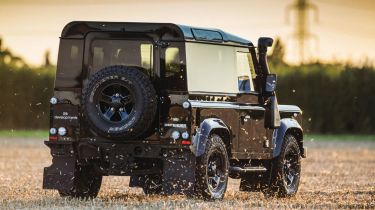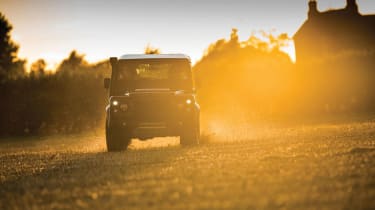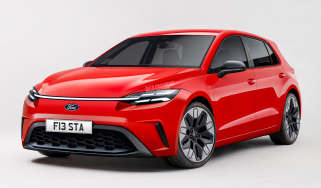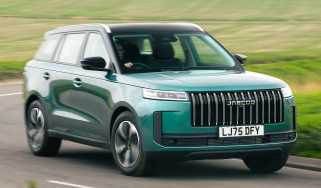The best ways to modify your Defender
When it comes to modifying your Land Rover, the smallest changes add up to make the biggest difference
Is there such a thing as a standard Land Rover? One of the joys of Land Rover ownership is the personal stamp we all put on our cars. Very few new vehicles ever get left totally showroom standard, virtually everything ends up receiving some sort of personal touch. Indeed, modifying them is a huge part of a Land Rover's appeal. It might be a simple compass fitted to the dashboard, but equally, it might be another axle, a rear crane, or a huge V8 engine. You name it, someone has done it, thought of it; liked it or hated it.That does raise the question perhaps of what is considered a good modification. Beauty is in the eye of the beholder, so we're not fit to properly judge what should or should not be done to a car we don't own. What one person likes, you can guarantee another will despise. That is just life. Where it gets interesting is where you can see it done with thought behind it.
Modifying with taste is a real skill in itself, and often doesn't involve much in the way of complex ideas. When LRM turned up a striking-looking 90, it taught us a lesson in how little you have to change to make a really big difference to a Defender. Our owner, who modestly prefers to remain anonymous, has had Land Rovers previous to this, in the shape of Range Rovers, Range Rover Sports and a brief tenure with a Discovery 4.
On deciding the time was right for a good, late model Defender, he spotted one for sale on the Pistonheads website that caught his eye. Only after he called did he realise it was a Td5 – something he didn't really want. However, a good chat with the owner brought up the name Ian Baughan, of IRB Developments. “The seller said whatever Defender I ended up with, I should definitely take it to IRB,” he says.
Eventually, our man found a good 2008 Defender, with the 2.4 litre Puma engine, and did indeed take to it IRB. There, it wasn't to remain standard. Despite looking smart in factory black paint, our man had a clear vision. He wanted full colour coding to the front lights and grille in matching Java Black, along with the wheels - factory 16” Boost alloys – and an IRB front bumper, incorporating two LED daytime running lights. For extra night vision, the factory headlights were ditched, and powerful JW Speaker 8700 EVO 2 models fitted in their place.
To complete the exterior, Vehicle Glazing Specialists' tinted Panoramic Privacy Glass and matching rear door glass to help echo the new darker front, as well as increase security. The colour-coding thing is a popular modification on the outside of Defenders, especially in black; who remembers BMW's popular Shadowline trim from the 1980s? There, the thing to do was simply a darker window and rain gutter trim. On a Defender, the black-on-black look does work particularly well, but it can look boxy. Smaller details do help break up the square shape however, like the wing-mounted snow cowl and raised snorkel.
The aesthetic side of the modifications is only half of the deal. The biggest change would need IRB's main skill set to address performance. We've seen their work before in LRM, and experienced the changes they make possible to the agility of all sorts of Land Rovers . “I'm not that mechanically minded, I just explained to Ian what I basically wanted, and he did the rest,” says our owner. Ian went for his IRB 450 Sport ECU calibration change, balanced with an IRB/PWR intercooler and an IRB modified air box to improve air flow. Ian's own calibrations do need to be driven to be believed, but the name PWR should be familiar if you're into motorsports. They make intercoolers for F1 and WRC cars, not typically the less rapid metal from Solihull. All change with IRB though, who worked in conjunction with PWR to develop Land Rover-specific items, resulting in IRB Developments.
What all those modification do is basically take the standard car, which makes 122 bhp and 266 lb ft of torque, to an improved and sensible 150 bhp and 332 lb ft. Those numbers do need investigating for a moment, because all isn't quite as you may think. In a standard car, drop the clutch in first gear and floor it, and how much torque is on tap, do you think? 266 lb ft? No; the ECU limits it to around 148-ish. Similar retardations occur in all gears. Only once in top sixth will the car release the full 266, to prevent driveline damage occurring. Ian's calibrations carefully massage this balance, to release more bang from the engine in each gear, without overly stressing the geartrain, and without even the need for an uprated paddle clutch kit, which can result in a heavy clutch pedal.
But enough of the back story. What really matters is what it is like to drive. Encouraged by Ian, I take it out on some local roads. The car doesn't even move before I notice the first difference; the engine idle note. It is hard to describe, but it definitely sounds different. Smoother; less chattery and, perhaps – to my ear at least – a little quieter. “You're probably right,” says Ian, when I question it. “The Ecu calibration alters a fair bit around the engine, so it is quite possible.”
Jumping behind the pedals I notice another sensible change; a slightly smaller MOMO steering wheel. Releasing the clutch, I'm immediately off on an empty, open A-road. With little traffic, I push up to top gear, and am really taken aback. It isn't Porsche 911 fast, but it is definitely noticeably more rapid than a standard Puma-engined Defender. Typical low gearing aside, standard Defenders can feel a little leaden, but the IRB modifications give it a pep like a rapid, much lighter, modern hatchback. Strikingly, it feels for all the world like you've either shaved half a ton off the vehicle, and that's because the engine is much more drivable, torquey and free-revving.
Back at base, I draw a few other conclusions, namely that there's a great deal of careful thought gone into this to make it what it is. It is more than just a spruced-up Defender 90, it drives and handles like you've always wanted one to, changing just enough to improve it without being over the top. Granted, the performance comes from IRB Development's skills, but the rest is down to not taking everything too far. The factory springs, sensible wheel diameter, combined with the smaller steering wheel mean ride and handling are still comfortable but not choppy, yet the narrower MOMO rim makes it much more pleasant to dial in the lock on tighter bends, as well as freeing up useful elbow room in the cab.
"There is a caveat to modifying; primarily that it can be addictive"
Out on the road, this is a really nice car indeed to pedal. In fact, I'd say it is the nicest-driving Puma 90 I've ever been in. “You're not the first to say that” says Ian. “Of all the cars I've done, there's definitely something special about this car, isn't there?” he admits. Our owner agrees, as I recount my thoughts on his car. “Its just a wonderful car to drive, and surprises many a Range Rover driver at traffic lights” he confesses. “I tend to start in second - accepting the clutch will probably wear - but it pulls so well in third and fourth, the difference [over standard] is like night and day” he enthuses. Despite mainly using it at weekends, it's fair to say he is more than pleased with what he has created. “I don't see myself as ever not owning that car” he says, neatly summising his thoughts on ownership so far.
What we learn here I suppose, is that to make a real difference to a Defender doesn't actually take that much. Cosmetics can be easily altered, but to really work, a subtle theme along the factory colours is always going to look sharp. To make the greatest improvement, perhaps the real lesson is all you really need is a little extra refinement and grunt, delivered in a usable, reliable way.
There is a caveat to modifying; primarily that it can be addictive. Since our photoshoot, showboating around an empty stubble field at sunset, our owner decided on a few more tweaks. “I've been back four times since to Ian,” he says, adding a NAS rear step, KBX wing tops, Exmoor leather sport seats, Bilstein B6 dampers, thicker anti-roll bars, Sawtooth alloys, and a black Alcantara headlining.
Don't think this has now over-egged the pudding. “I've taken it as far as I can now, and can't think of anything else it needs” says our owner. That probably neatly brackets the lessons learned from this 90; know when to start; know what to do; and crucially, know when to stop.
Contact:
IRB Developments: www.irbdevelopments.comVGS: www.vehicleglazingspecialists.com/
Find a car with the experts










